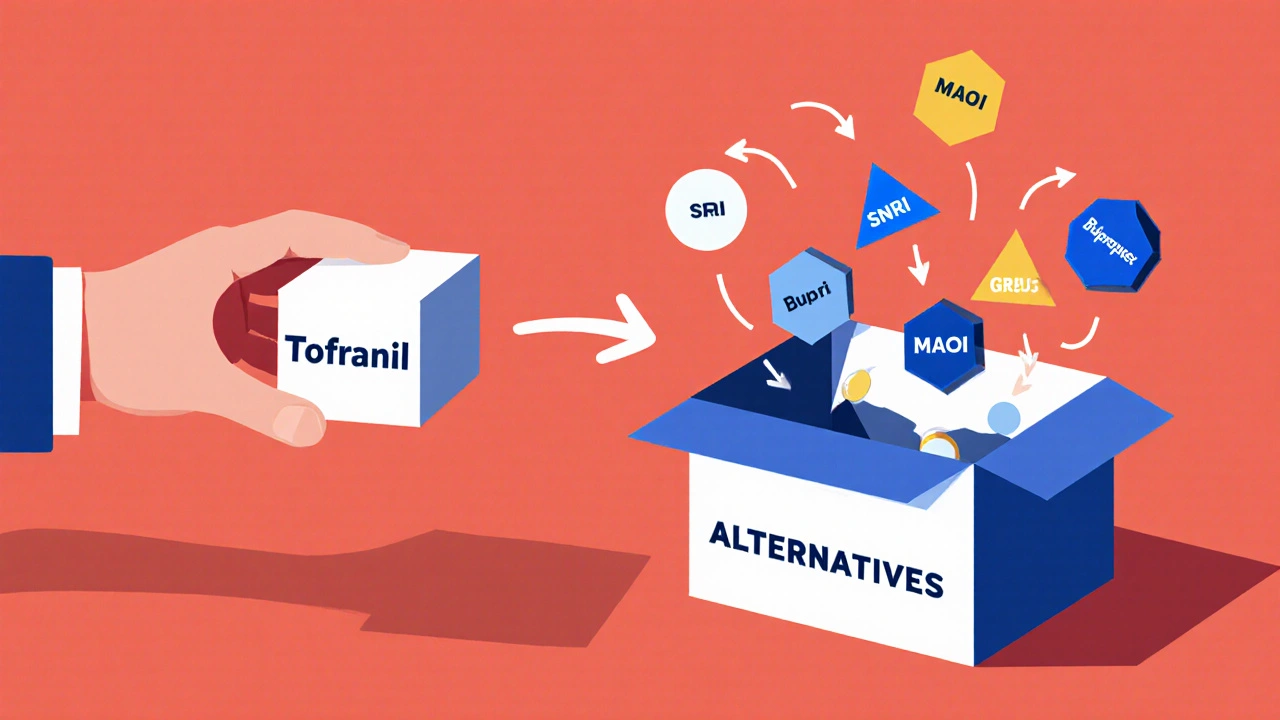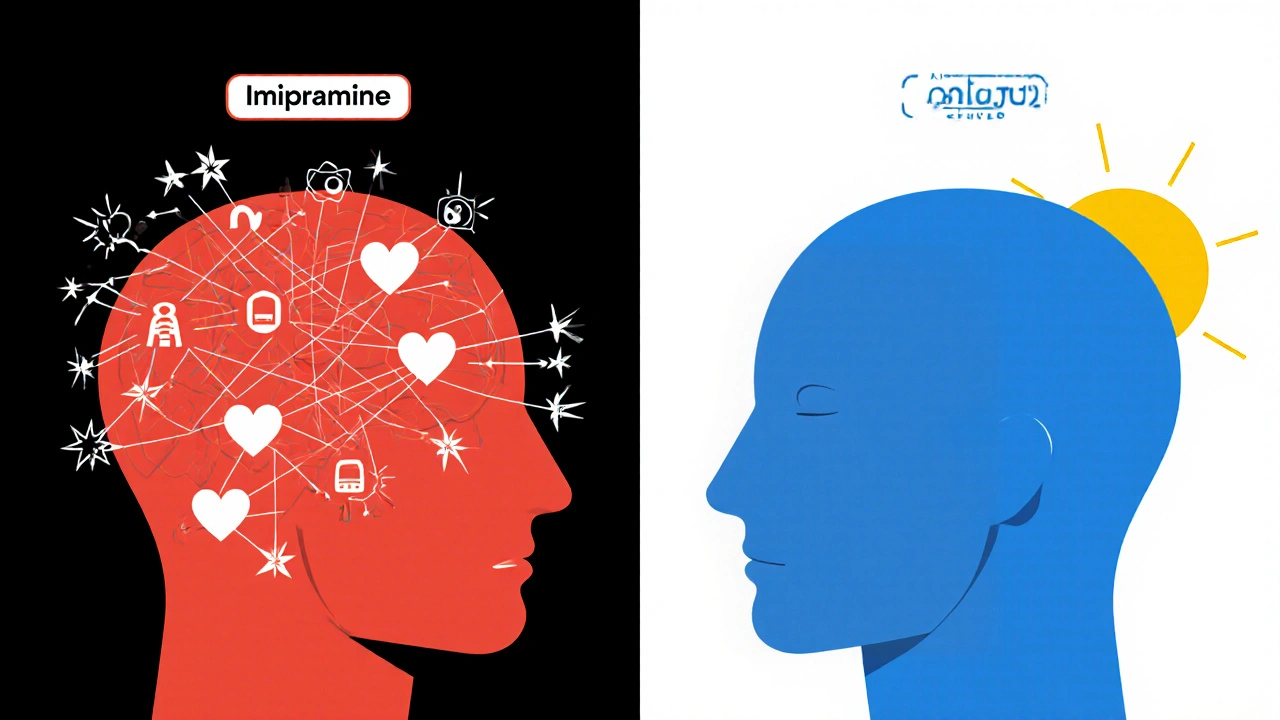If you're taking Tofranil (imipramine) for depression or anxiety, you might be wondering if there's a better option. Maybe the side effects are getting to you-dry mouth, drowsiness, weight gain-or maybe it just isn't working as well as you hoped. You're not alone. Many people on imipramine look for alternatives, especially as newer meds hit the market. But not all alternatives are created equal. Some work faster. Some have fewer side effects. Others cost less. Let’s break down what’s out there, what actually works, and who each option is best for.
What is Tofranil (Imipramine)?
Tofranil is the brand name for imipramine, a tricyclic antidepressant (TCA) first approved in the 1950s. It was one of the first drugs developed to treat depression and is still used today, especially for treatment-resistant cases. It also works for panic disorder, bedwetting in children, and some chronic pain conditions.
Imipramine works by increasing serotonin and norepinephrine in the brain-two chemicals tied to mood regulation. But it doesn’t pick and choose. It hits multiple receptors, which is why side effects are common: dry mouth, blurred vision, constipation, dizziness, weight gain, and heart rhythm changes. It also takes 4-6 weeks to show full effect, and if you miss a dose, withdrawal symptoms can hit fast.
Why Look for Alternatives?
People stop Tofranil for a few clear reasons:
- Side effects are too uncomfortable-especially for older adults or those with heart issues
- It doesn’t lift mood enough after 8 weeks
- They’re on other meds that interact badly with it (like MAOIs or certain painkillers)
- They want something faster-acting or with less risk of overdose
For many, the trade-off isn’t worth it. That’s where alternatives come in.
SSRIs: The Most Common Switch
Selective Serotonin Reuptake Inhibitors (SSRIs) are the go-to replacement for imipramine. They’re safer, better tolerated, and just as effective for most people with depression or anxiety.
Fluoxetine (Prozac) is often the first pick. It has a long half-life, so missing a dose isn’t as big a deal. It’s also less likely to cause weight gain than imipramine. But it can cause nausea early on and sometimes makes people feel jittery.
Sertraline (Zoloft) is another top choice. Studies show it works as well as imipramine for depression and anxiety, but with fewer dry mouth and constipation issues. It’s also used for OCD and PTSD, so if you have those too, sertraline covers more ground.
Citalopram (Celexa) and escitalopram (Lexapro) are gentler on the heart. If you’re over 60 or have a history of arrhythmias, these are safer than Tofranil. Lexapro, in particular, has strong data backing it for generalized anxiety disorder.
SSRIs aren’t perfect-they can cause sexual side effects in up to 60% of users-but they’re far less dangerous in overdose and don’t require regular blood tests like imipramine does.
SNRIs: A Middle Ground
If SSRIs don’t cut it, Serotonin-Norepinephrine Reuptake Inhibitors (SNRIs) are the next step. They work like imipramine but with more precision.
Venlafaxine (Effexor) is the closest in effect to imipramine. It boosts both serotonin and norepinephrine, just like Tofranil. Many people who didn’t respond to SSRIs find relief with venlafaxine. But it can raise blood pressure and cause nausea or sweating.
Duloxetine (Cymbalta) is great if you also have nerve pain or fibromyalgia. It’s approved for both depression and chronic pain, making it a two-in-one option. It’s also less likely to cause weight gain than imipramine.
SNRIs are often more effective than SSRIs for people with low energy or physical symptoms of depression-but they’re not first-line anymore because of side effects and cost.

Atypical Antidepressants: Different Mechanisms
Some alternatives don’t work like imipramine at all. That’s not a bad thing.
Bupropion (Wellbutrin) is the only major antidepressant that doesn’t affect serotonin. It boosts dopamine and norepinephrine. That means it’s less likely to cause sexual side effects or weight gain. Many people switch to bupropion after struggling with those issues on Tofranil or SSRIs. It’s also used for smoking cessation. But it can cause insomnia or anxiety in some.
Mirtazapine (Remeron) works by blocking certain receptors, which actually increases serotonin and norepinephrine indirectly. It’s known for helping with sleep and appetite-so if you’ve lost weight or can’t sleep on imipramine, this might help. But it causes drowsiness and can lead to weight gain, sometimes even more than Tofranil.
MAOIs: The Old Guard
Monamine Oxidase Inhibitors (MAOIs) like phenelzine or tranylcypromine are older than imipramine. They’re rarely used now because they require strict diet restrictions (no aged cheese, wine, pickled foods) and can interact dangerously with common meds like decongestants or SSRIs.
But for treatment-resistant depression-where SSRIs, SNRIs, and TCAs have all failed-MAOIs can be a lifeline. Studies show they work better than TCAs in about 30% of these cases. They’re not a first choice, but they’re not obsolete.
Comparison Table: Tofranil vs. Top Alternatives
| Medication | Class | Onset of Action | Common Side Effects | Overdose Risk | Best For |
|---|---|---|---|---|---|
| Tofranil (Imipramine) | Tricyclic Antidepressant (TCA) | 4-6 weeks | Dry mouth, drowsiness, weight gain, constipation, heart rhythm changes | High | Treatment-resistant depression, panic disorder, bedwetting |
| Sertraline (Zoloft) | SSRI | 4-6 weeks | Nausea, diarrhea, sexual dysfunction, insomnia | Low | Depression, anxiety, OCD, PTSD |
| Venlafaxine (Effexor) | SNRI | 2-4 weeks | Nausea, sweating, increased blood pressure, dizziness | Medium | Depression with fatigue, anxiety, when SSRIs fail |
| Bupropion (Wellbutrin) | Atypical | 2-4 weeks | Insomnia, dry mouth, agitation, seizures (rare) | Medium | Low energy, sexual side effects, smoking cessation |
| Mirtazapine (Remeron) | Atypical | 1-2 weeks | Drowsiness, increased appetite, weight gain | Low | Depression with insomnia or weight loss |
| Phenelzine (Nardil) | MAOI | 2-4 weeks | Dizziness, weight gain, dietary restrictions, hypertensive crisis risk | High | Treatment-resistant depression, atypical depression |
Who Should Avoid Tofranil?
You should probably skip imipramine if you have:
- Heart disease, especially arrhythmias or recent heart attack
- Glaucoma
- Enlarged prostate or trouble urinating
- History of seizures
- Are over 65 (higher risk of confusion, falls, and heart issues)
- Take other medications that affect heart rhythm (like certain antibiotics or antifungals)
If any of these apply to you, an SSRI or SNRI is almost always a safer bet. Doctors in Australia and the U.S. now recommend TCAs like Tofranil only after other options have failed.

What About Natural Options?
St. John’s Wort is sometimes suggested as a natural alternative. It’s been studied for mild to moderate depression and works similarly to SSRIs. But here’s the catch: it interacts with dozens of medications-including birth control, blood thinners, and HIV drugs. It can also cause serotonin syndrome if taken with SSRIs. In Australia, it’s sold as a supplement, but it’s not regulated like prescription meds. Most doctors won’t recommend it because of the risks.
Exercise, CBT (cognitive behavioral therapy), and sleep hygiene are proven to help depression too. In fact, combining therapy with medication often works better than either alone. If you’re on Tofranil and still struggling, adding therapy might be more helpful than switching meds.
How to Switch Safely
Never stop Tofranil cold turkey. Withdrawal can cause flu-like symptoms, anxiety, dizziness, and even rebound depression. Tapering down slowly over weeks is essential.
If switching to an SSRI or SNRI, your doctor might use a “washout” period-stopping imipramine for 1-2 weeks before starting the new drug. This avoids dangerous interactions. For some, they’ll start the new med at a low dose while slowly reducing Tofranil.
Always work with a doctor. Switching antidepressants isn’t like changing painkillers. It needs monitoring, especially in the first few weeks.
Cost and Accessibility
In Australia, imipramine is available on the PBS (Pharmaceutical Benefits Scheme), so it costs around $7-$30 per script depending on your status. Most SSRIs and SNRIs are also subsidized, so the price difference isn’t huge.
Brand-name versions (like Zoloft or Lexapro) cost more, but generics are cheap and just as effective. If cost is a barrier, ask your doctor for the generic version. You’re not losing anything by choosing it.
Final Thoughts: When to Switch
Switching from Tofranil makes sense if:
- You’re having intolerable side effects
- You’re not improving after 8 weeks
- You have heart problems or are over 65
- You want something with less risk of overdose
But if Tofranil is working, and you’re managing the side effects, there’s no rush to change. Many people stay on it for years. The goal isn’t to use the newest drug-it’s to find what keeps you stable and feeling like yourself.
There’s no one-size-fits-all antidepressant. What works for someone else might not work for you. The best choice is the one that balances effectiveness, safety, and your daily life.
Is Tofranil still used today?
Yes, but rarely as a first choice. Tofranil (imipramine) is still prescribed for treatment-resistant depression, panic disorder, and bedwetting in children. Most doctors now start with SSRIs or SNRIs because they’re safer and better tolerated. TCAs like imipramine are usually tried only after other options fail.
What’s the safest antidepressant for older adults?
Escitalopram (Lexapro) and sertraline (Zoloft) are considered the safest for older adults. They have fewer interactions with other meds, lower risk of heart rhythm problems, and less impact on balance or cognition. Imipramine is generally avoided in people over 65 due to higher risks of confusion, falls, and arrhythmias.
Can I switch from Tofranil to Zoloft on my own?
No. Switching antidepressants without medical supervision can cause serious side effects, including serotonin syndrome or severe withdrawal. Always work with your doctor. They’ll create a tapering plan and may overlap medications temporarily to avoid crashes.
Do alternatives work faster than Tofranil?
Some do. SNRIs like venlafaxine and atypical antidepressants like mirtazapine can start working in 1-2 weeks for some people, while imipramine usually takes 4-6 weeks. But no antidepressant works instantly. The speed difference is modest, and long-term effectiveness matters more than how fast you feel better.
Is there a natural alternative to Tofranil?
St. John’s Wort has been shown to help mild to moderate depression, but it’s not a reliable substitute. It interacts dangerously with many medications, including birth control and blood thinners. It’s not regulated like prescription drugs, and its strength varies by brand. Most doctors advise against it as a replacement for imipramine.
What if nothing works after trying alternatives?
If multiple antidepressants fail, your doctor might consider MAOIs like phenelzine, which are more effective for treatment-resistant cases. Other options include adding lithium or thyroid hormone, or exploring non-medication treatments like TMS (transcranial magnetic stimulation) or ketamine therapy. Therapy, especially CBT, is also critical at this stage. You’re not out of options-you just need a different strategy.


Brad Seymour
Man, I switched from Tofranil to Zoloft last year after six months of dry mouth and feeling like a zombie. No more constipation, no more heart palpitations - and my anxiety actually improved. Still get the occasional libido slump, but hey, I’m alive and functioning. Worth it.